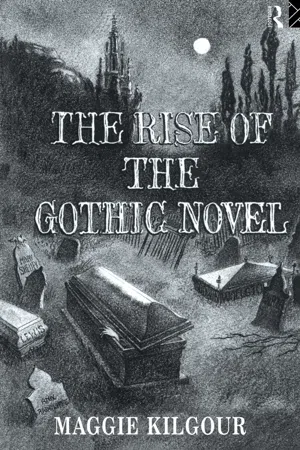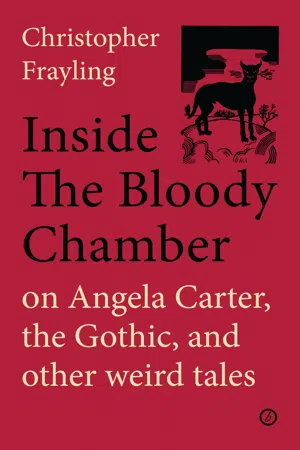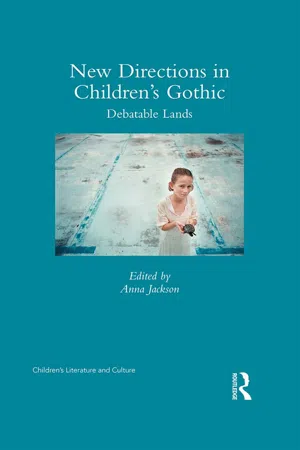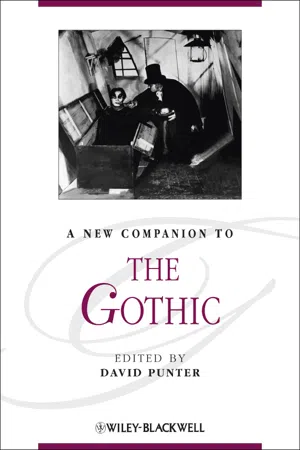Gothic Novel
The Gothic novel is a genre of fiction that emerged in the 18th century, characterized by elements of horror, mystery, and the supernatural. These novels often feature eerie settings, melodramatic plots, and complex characters, and they explore themes such as the unknown, the macabre, and the psychological. Key examples of Gothic novels include Mary Shelley's "Frankenstein" and Bram Stoker's "Dracula."
8 Key excerpts on "Gothic Novel"
- eBook - ePub
- Maggie Kilgour(Author)
- 2013(Publication Date)
- Routledge(Publisher)
...1 The Nature of Gothic DOI: 10.4324/9781315800226-1 One of the powerful images conjured up by the words ‘Gothic Novel’ is that of a shadowy form rising from a mysterious place: Frankenstein’s monster rising from the laboratory table, Dracula creeping from his coffin, or, more generally, the slow opening of a crypt to reveal a dark and obscure figure. This iconography has haunted various critical representations of the rise of the genre. The imagery supports psychoanalytical critics’ contention that the gothic reflects the return of the repressed, in which subconscious psychic energy bursts out from the restraints of the conscious ego. The emergence of the gothic in the eighteenth century has also been read as a sign of the resurrection of the need for the sacred and transcendent in a modern enlightened secular world which denies the existence of supernatural forces, or as the rebellion of the imagination against the tyranny of reason. Recent historical studies have positioned the genre more specifically in relation to the rise of the middle class and the novel proper, with which that class has been identified, since Ian Watt especially. In general, the gothic has been associated with a rebellion against a constraining neoclassical aesthetic ideal of order and unity, in order to recover a suppressed primitive and barbaric imaginative freedom. Until recently therefore, the Gothic Novel has often been treated also as a kind of generic missing link between the romance and the novel, a very low road to Scott, whose rise is a deviation in the evolutionary chain that leads from Enlightenment to Romanticism...
- eBook - ePub
- Angela Wright(Author)
- 2007(Publication Date)
- Bloomsbury Academic(Publisher)
...In The Rise of the Gothic Novel (1995), Kilgour argues that: … one of the factors that makes the gothic so shadowy and nebulous a genre, as difficult to define as any gothic ghost, is that it cannot be seen in abstraction from the other literary forms from whose grave it arises, or from its later descendants who survive after its demise, such as the detective novel and horror movie. It feeds upon and mixes the wide range of literary sources out of which it emerges and from which it never fully disentangles itself: British folklore, ballads, romance, Elizabethan and Jacobean tragedy (especially Shakespeare), Spenser, Milton, Renaissance ideas of melancholy, the graveyard poets, Ossian, the sublime, sentimental novelists (notably [Abbé] Prevost [1697–1763], [Samuel] Richardson, and [Jean-Jacques] Rousseau [1712–78]), and German traditions (especially [ The Robbers (1781) and Ghost-Seer (1789), by Friedrich] Schiller [1759–1805]). The form is thus itself a Frankenstein’s monster, assembled out of the bits and pieces of the past. While it therefore can at times seem hopelessly naïve and simple, it is, at its best, a highly wrought artificial form which is extremely self-conscious of its artificiality and creation out of old material and traditions. 53 The anatomy of Mary Shelley’s monster, sewn together from different bodies which have been obtained through occasionally illegitimate means, provides a good way of thinking around the concerns and literary genres from which the Gothic romance is born in the late eighteenth century. The following chapters examine the critical appraisals of both the aesthetic sources and the political and psychological concerns which give life blood to the Gothic romance on the cusp of the eighteenth and nineteenth centuries....
- eBook - ePub
The Literature of Terror: Volume 1
The Gothic Tradition
- David Punter(Author)
- 2014(Publication Date)
- Routledge(Publisher)
...Chapter 2 The origins of Gothic fiction Sentimentalism, Poetry Graveyard, Sublime The, Sublime Smollett, Horace Walpole, Clara Reeve and Sophia Lee DOI: 10.4324/9781315843476-2 The origin of Gothic fiction cannot be separated from the origin of the novel form itself. As we are all now well aware, the eighteenth century was the era of the rise of the novel. There had, of course, been many forms of literary prose prior to the eighteenth century, some of them well developed, particularly the prose romance; but the works of Richardson and Fielding in the 1740s nevertheless marked an enormous change in prose writing – specifically, the abandonment of the fanciful in the name of a realistic depiction of contemporary life. This statement would need much amplification and qualification if we were concerned here with attempting to define the novel: but for our purposes it is sufficient to bear in mind the new realism which appeared in the writings of the mideighteenth century, a realism of course in some ways prefigured by the semifictional narratives of Defoe. Where the romance-wri te rs of the sixteenth and seventeenth centuries had chosen archaic, mythic or fanciful settings, events in Clarissa Harlowe (1748) and Tom Jones (1749) occurred in the midst of a contemporary world, and were related to the production and vindication of a contemporary morality. The question of the relation between Gothic and the rise of the novel in general is related to that of how it was possible for a new literary form to emerge in this way; and what occasioned such a massive change in the panorama of literary production. The principal point here is the eighteenth-century change in English social structure and the associated development of the reading public...
- eBook - ePub
Reading Historical Fiction
The Revenant and Remembered Past
- Kate Mitchell, N. Parsons(Authors)
- 2012(Publication Date)
- Palgrave Macmillan(Publisher)
...And it engenders fear. It is this relationship between the Gothic reader, history and fear that I want to explore here. The early entanglement between the two genres is, as David Punter has reminded us, partly because the Gothic ‘seems to have been a mode of history’ (1996, 52). It was a way of re -presenting, or symbolising, an obscure past that foregrounds the possibility of its repetition. The first Gothic Novel by a woman, Clara Reeve’s The Old English Baron (1777), rewrote The Castle of Otranto, moving the genre towards realism precisely by situating it within a specific historical location – early fifteenth-century England. Reeve’s novel is, in E. J. Clery’s suggestive phrase, ‘a reading lesson, as The Castle of Otranto had been’ (2000, 32). It uses what Clery calls a ‘tripartite system of narrative’, mixing the marvellous (including the supernatural), the probable (historical realism) and the sentimental (including a moral sympathy) to fully engage the heart and mind of her reader (32). Given that it was precisely the inclusion of non-realist elements like the supernatural that led critics such as Georg Lukács to dismiss Gothic Novels as forerunners of the historical novel, the work of Punter and Clery gives us an alternative tradition that can connect the historical novel with the Gothic. This is especially important in relation to women writers who often turned to Gothic historical fiction because they were excluded from more traditional historiographies. 1 The affective response of the reader is central to the definition of the Gothic given by Ellen Moers in her pioneering Literary Women (1976). ‘But what I mean – or anyone else means – by “the Gothic” is not so easily stated except that it has to do with fear,’ she wrote (1978, 90). The Gothic had ‘one definite auctorial intent: to scare. [. ...
- eBook - ePub
- Jerome De Groot(Author)
- 2009(Publication Date)
- Routledge(Publisher)
...The text is hugely influential in Chinese culture but has been little considered in the West. With this caveat, it can be argued that the novel increasingly emerged as a definable form during the latter part of the eighteenth century. Historical fictions were written throughout the last decades of the century, drawing on earlier examples like the works of Daniel Defoe (?1660–1731), Lafayette's Princess of Clevès and Thomas Leland's Longsword (1762). Novel readers were generally thought of as less respectable than those of poetry. In the 1800 Preface to the Lyrical Ballads William Wordsworth famously derided novels as being sensational and demeaning. As a literary form, the novel developed out of other genres such as romance, epic, autobiography, and was consistently in dialogue with its origins, in particular with the prose romance. Romance traditionally dealt with chivalry, knights, feminine perfection and mythical elements. Some novels, particularly those by Samuel Richardson and Jane Austen, avoided this association, and were interested in newly detailed psychological realism. However, the form that we shall be looking at was clearly indebted to the romance, and in particular to the example of Don Quixote. Gothic NovelS AND THE FETISHISATION OF EUROPEAN HISTORY A key type of historical fiction was that evinced by the Gothic Novel, popular during the latter half of the eighteenth century. Gothic is a type of writing which is fascinated by the unknown and mysterious, with the terrifying and the haunting. Gothic Novels fetishised European history. They were often set during the medieval period, and their interest in this past was a fascination with savagery and mystery. Horace Walpole's The Castle of Otranto, for instance, often taken to be the first Gothic Novel, is fascinated by the horrific possibilities of the past...
- eBook - ePub
Inside the Bloody Chamber
Aspects of Angela Carter
- Christopher Frayling(Author)
- 2015(Publication Date)
- Oberon Books(Publisher)
...There have been debates about definitions of ‘the Gothic’ – should the term apply, strictly speaking, only to the period between 1764 (The Castle of Otranto) and 1816 (Frankenstein) or maybe 1820 (Maturin’s Melmoth the Wanderer), or should it have much broader application to the heirs of the Gothic in Victorian, twentieth- and twenty-first-century popular culture? John Ruskin famously wrote, in his Seven Lamps of Architecture, ‘I use the word Gothic in the most extended sense as broadly opposed to classical – that it admits a richness of record altogether unlimited’. Many today would agree. Including curator Martin Myrone, who has observed: …the term Gothic is also widely employed in relation to modern and contemporary literature in the English language and otherwise, cinema, art, and cultural criticism. It may be taken to refer to certain structural tendencies to distortion, the grotesque, and uncanny, rather than a definable, limited genre. As the scholarly industry around the Gothic has proliferated, so Gothicisms have multiplied, so that we might now consider a vast array of historical, generic and geographical versions of the Gothic… Also there have been debates between those who prefer to emphasise psychoanalytical approaches (as applied to authors and readers) and those who are more interested in the redescription of immediate historical contexts – such as the rise of consumerism in the late eighteenth century with its ephemeral choices and shifting fashions, the expansion of the reading public, the commercialisation of publishing, the complex impact of the French Revolution, the politics of gender, all of them presenting a new challenge to fixed social hierarchies. The context of gender has led – at its best – to a welcome reappraisal of the work of Ann Radcliffe from the points of view of women’s property rights and family structures in a patriarchal age...
- eBook - ePub
New Directions in Children's Gothic
Debatable Lands
- Anna Jackson, Anna Jackson(Authors)
- 2017(Publication Date)
- Routledge(Publisher)
...The audience for Gothic Novels was generally presumed to be young and female. The anonymous author of ‘Terrorist Novel Writing’ of 1798, for example, stressed that ‘A novel, if at all useful, ought to be a representation of human life and manners, with a view to direct the conduct in the most important duties of life, and to correct its follies … Can a young lady be taught nothing more necessary in life, than to sleep in a dungeon with venomous reptiles, walk through a ward [wood] with assassins, and carry bloody daggers in their pockets, instead of pin-cushions and needle-books?’ (in Clery and Miles 2000: 184). The mis-teaching of history in particular is singled out by Richard Graves in 1790, commenting on Sophia Lee’s The Recess (1785). Graves deplores the historical romance for mixing ‘truth with fiction in such a manner as must necessarily lead young minds into error, and introduce confusion into all history’ and gives the example of a card-playing acquaintance who insists that Mary Queen of Scots had two illegitimate children because ‘I have just been reading an entertaining novel, which is founded entirely upon that fact ’ (in Clery and Miles 2000: 182). While there were defences of the Gothic Novel which uncannily pre-empt those of critics today, such as that of E.A., who proposes in 1798 that ‘They induce persons to read, who, but for these, would never read at all’ (in Clery and Miles 2000: 208), the overwhelming consensus was that they were at best useless and at worst actively pernicious. Literature written specifically for children, which emerged as a genre almost exactly contemporaneously with Gothic in the later eighteenth century, accordingly tended to excise gothic impulses...
- eBook - ePub
- David Punter, David Punter(Authors)
- 2012(Publication Date)
- Wiley-Blackwell(Publisher)
...Certainly postmodernism has seen a further set of dealings with terror and even a reinvigoration of the apparently more dated trappings of the Gothic (one might think, for example, of the extraordinary, nightmarish castles so frequently encountered in the pages of Iain Banks), but on the other hand one could say that, after all, in postmodernism everything is resurrected, or at least reexamined, if only to be consigned again to the generically confused charnel-house of history. So here there are many uncertainties, and it is obviously possible to view this uncertainty about the field of Gothic writing as, if not exactly a virtue, at least a significant resistance to canonization: this book, for example, is not going to answer the question “What is Gothic?” any more than any other book has managed to provide an enduring answer to questions such as “What is the novel?” or “What is romanticism?” What can, however, be said – and I am now moving on to the second issue, of the relation between Gothic and contemporary ideas – is that, in recent years in particular, we have found ourselves at a peculiar confluence between the major motifs of the Gothic and a set of ways of thinking increasingly current in contemporary criticism and theory. Gothic speaks of phantoms: the neo-psychoanalytic ideas of Abraham and Torok, following Freud, are based on a redescription of the phantom. Gothic takes place – very frequently – in crypts: Abraham and Torok, again, make the crypt the cornerstone of their psychic topography. The Gothic speaks of – indeed, we might say it attempts to invoke – specters: Derrida, in, for example, Specters of Marx, chooses the same post-Marxist rhetoric to talk about what we might term the “suppressed of Europe.” Gothic has to do with the uncanny: the uncanny has now come to form one of the major sites on which reinvestigations of the mind, from both the psychoanalytic and also the neuropsychological points of view, can take place...







